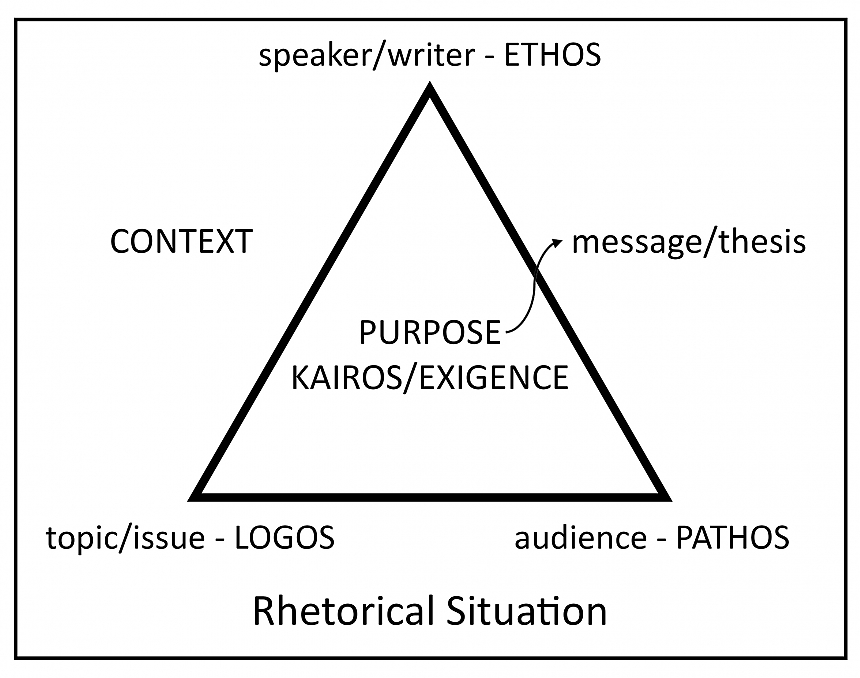Rhetoric is the art and skill of persuasive communication. Sometimes it is defined more broadly as the art of effective communication by those who wish to recognize that the purpose of communicating is not always strictly to persuade. Usually, rhetoric refers to writing or speaking, but other modes of communication or expression can be considered rhetorically (thus, the term visual rhetoric).
Rhetorical analysis: A process or piece of writing that examines a speaker or writer’s use of rhetorical techniques in a given speech or text they have produced.
Rhetorical approaches or strategies: Ways of organizing communication. Within any given presentation or piece of writing, several usually work in combination. These strategies often have predictable patterns and key words and are also called rhetorical patterns, patterns of development, or modes of discourse.
- Narration (narrating) means telling a story. Narratives are usually in chronological order.
- Description (describing) is done to present an image of a person, place, object, feeling, or experience to a reader using sensory details, often in spatial order.
- Illustration (illustrating) makes a general statement and supports it by providing a specific example or examples.
- Comparison (comparing/contrasting) is done to analyze and explain how two or more things, people, or ideas are similar or different. The structure can follow subject-by-subject and/or point-by-point and usually includes both similarities and differences. An analogy is an extended metaphor that compares a subject—something less familiar—to something more familiar that has similar elements in order to make the subject more understandable.
- Process analysis (analyzing a process) is done to explain how to do something (directive) or how something happened, happens, or will happen (informative), usually in sequential order.
- Definition (defining) is used to explain the extended meaning of a word through etymology, examples, negation, analogy, denotation, connotation, or a combination of these methods.
- Classification (classifying) is an approach of categorizing or grouping things, people, places, and ideas based on specific criteria.
- Cause and effect analysis is used to examine and explain why (causes) an event, action, situation, or problem happened, happens, or will happen, and/or its consequences (effects). For example, cost/benefit or problem-solution analyses usually examine causes and effects.
A rhetorical situation occurs when a speaker, audience, and topic converge within a context to create a rhetorical act (such as a speech or written text).
The rhetorical triangle is a visual model of the rhetorical situation that helps us to analyze any act of communication. (See the diagram below.) The three points of the triangle represent the speaker/writer, the audience/reader, and the topic/issue. This is also called the Aristotelian triangle because Aristotle (Greek philosopher, 384 – 322 BC) first described the interaction among topic, speaker, and audience.

These three points of the rhetorical triangle can also be connected to the three main rhetorical appeals: ethos, pathos, logos, as well as an appeal, known as kairos.
Rhetorical appeals are ways a writer can use evidence and language to achieve an effect on or reaction from the audience.
- Ethos has to do with assuring the audience/readers of the credibility of the speaker/writer. How can the speaker or writer show the audience that they are trustworthy, honest, fair, well-informed, objective?
- Pathos has to do with appealing to the emotions of the audience/readers. How is the writer trying to get the readers to care or feel an emotional connection to the topic?
- Logos refers to the facts presented and the logical reasoning underlying the message/thesis. Does the writer provide sufficient credible and relevant information and use logical, reasoned argument to reach conclusions?<
- Kairos is sometimes left out of discussions about rhetorical appeals, perhaps because it is a little harder to explain and understand. Kairos means exigence, which is what prompts an author to write in the first place. Kairos can be seen as a person’s need or reason to respond to a situation, problem, statement, action, or event by speaking or writing about it.